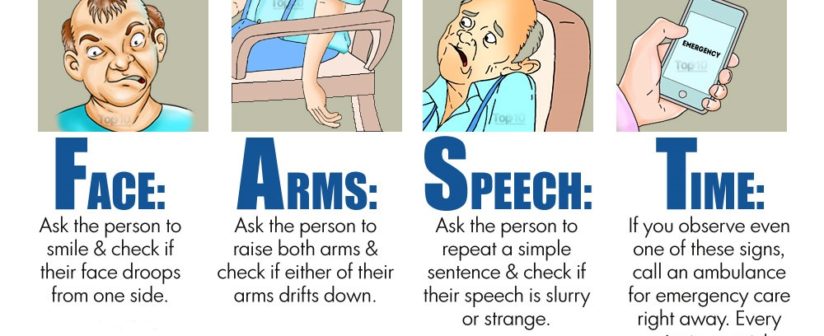Knowing the signs of a stroke is the first step in stroke prevention. A stroke, sometimes called a “brain attack,” occurs when blood flow to an area in the brain is cut off. The brain cells, deprived of the oxygen and glucose needed to survive, die. If a stroke is not caught early, permanent brain damage or death can result.
How Does a Stroke Occur?
There are two types of stroke.
Ischemic stroke is similar to a heart attack, except it occurs in the blood vessels of the brain. Clots can form in the brain’s blood vessels, in blood vessels leading to the brain, or even in blood vessels elsewhere in the body and then travel to the brain. These clots block blood flow to the brain’s cells. Ischemic stroke can also occur when too much plaque (fatty deposits and cholesterol) clogs the brain’s blood vessels. About 80% of all strokes are ischemic.
Hemorrhagic (heh-more-raj-ik) strokes occur when a blood vessel in the brain breaks or ruptures. The result is blood seeping into the brain tissue, causing damage to brain cells. The most common causes of hemorrhagic stroke are high blood pressure and brain aneurysms. An aneurysm is a weakness or thinness in the blood vessel wall.
Symptoms
Watch for these signs and symptoms if you think you or someone else may be having a stroke. Note when your signs and symptoms begin, because the length of time they have been present may guide your treatment decisions:
- Trouble with speaking and understanding.You may experience confusion. You may slur your words or have difficulty understanding speech.
- Paralysis or numbness of the face, arm or leg.You may develop sudden numbness, weakness or paralysis in your face, arm or leg, especially on one side of your body. Try to raise both your arms over your head at the same time. If one arm begins to fall, you may be having a stroke. Similarly, one side of your mouth may droop when you try to smile.
- Trouble with seeing in one or both eyes.You may suddenly have blurred or blackened vision in one or both eyes, or you may see double.
- A sudden, severe headache, which may be accompanied by vomiting, dizziness or altered consciousness, may indicate you’re having a stroke.
- Trouble with walking.You may stumble or experience sudden dizziness, loss of balance or loss of coordination.
Recognising the signs of a stroke
The signs and symptoms of a stroke vary from person to person, but usually begin suddenly.
As different parts of your brain control different parts of your body, your symptoms will depend on the part of your brain affected and the extent of the damage.
The main stroke symptoms can be remembered with the word F.A.S.T.
- Face – the face may have dropped on one side, the person may not be able to smile, or their mouth or eye may have drooped.
- Arms – the person with suspected stroke may not be able to lift both arms and keep them there because of weakness or numbness in one arm.
- Speech – their speech may be slurred or garbled, or the person may not be able to talk at all despite appearing to be awake.
- Time – it’s time to call doctor immediately if you notice any of these signs or symptoms.
It’s important for everyone to be aware of these signs and symptoms, particularly if you live with or care for somebody in a high-risk group, such as someone who is elderly or has diabetes or high blood pressure.
Stroke Complications
After you’ve had a stroke, you may develop other complications, such as:
- Blood clots and muscle weakness. Being immobile (unable to move around) for a long time can raise your risk of developing blood clots in the deep veins of the legs. Being immobile also can lead to muscle weakness and decreased muscle flexibility.
- Problems swallowing and pneumonia. If a stroke affects the muscles used for swallowing, you may have a hard time eating or drinking. You also may be at risk of inhaling food or drink into your lungs. If this happens, you may develop pneumonia.
- Loss of bladder control. Some strokes affect the muscles used to urinate. You may need a urinary catheter (a tube placed into the bladder) until you can urinate on your own. Use of these catheters can lead to urinary tract infections. Loss of bowel control or constipation also may occur after a stroke.
Preparation
You can prepare for stroke if you know you’re at risk for one. These steps include:
- educating family and friends about “FAST”
- wearing medical identification jewelry for medical staff
- keeping updated medical history on hand
- having emergency contacts listed on your phone
- keeping a copy of your medications with you
- teaching children how to call for help
If one is available, knowing the address of the hospital in your area with a designated stroke center is helpful.
Prevention
Having a stroke increases your risk for another one. The best treatment for a stroke is prevention.
You can take steps to minimize your risk factors for having a stroke by:
- eating more veggies, beans, and nuts
- eating more seafood instead of red meat, poultry, and eggs
- limiting intake of sodium, fats, sugars, and refined grains
- increasing exercise
- limiting or quitting tobacco use
- drinking alcohol in moderation
- taking prescribed medications for conditions, such as high blood pressure, as directed


